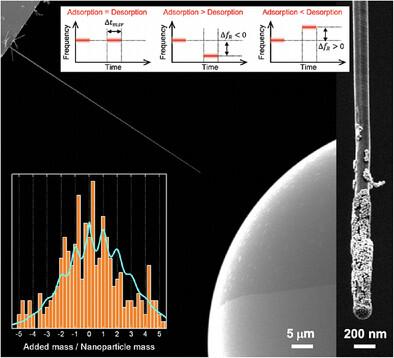Dip‐in Nanomechanical Probes for Mass Characterization of Nanoparticles in Ultra‐Low Volume Liquid Suspensions
IF 12.1
2区 材料科学
Q1 CHEMISTRY, MULTIDISCIPLINARY
引用次数: 0
Abstract
The mass of nanoparticles has a critical influence on their phenomenology and functional performance, driving the need for measurement tools that combine high‐throughput with high‐resolution single‐particle analysis. Mass characterization of large nanoparticle populations under such demands remains a persistent challenge, particularly for nanoparticles of large mass, where consolidated techniques encounter limitations. Here, a dip‐in nanomechanical probe sensing approach for weighing nanoparticles in liquid suspensions which simultaneously provides high mass resolution and sensing rate is demonstrated. The method relies on nanoparticle transfer to nanowire resonator probes via iterative immersion into the suspension, requiring minimal volume and resulting in negligible losses. It also introduces ionic liquids as suspension media, enabling vacuum operation for optimizing mass resolution through single‐mode resonance frequency tracking of the probes. Additionally, implementing acoustofluidic actuation on the suspension regulates nanoparticle adsorption/desorption during immersion, significantly enhancing the sensing rate. Measurements of 30 nm gold nanoparticles demonstrate accurate characterization of their mass distribution with a probe resolution of 0.1 ag, a sensing rate of 38 NPs min

浸入式纳米机械探针用于超低体积液体悬浮液中纳米颗粒的质量表征
纳米颗粒的质量对其现象学和功能性能有关键影响,这推动了对高通量和高分辨率单颗粒分析相结合的测量工具的需求。在这样的要求下,大的纳米粒子群的质量表征仍然是一个持续的挑战,特别是对于大质量的纳米粒子,在那里综合技术遇到了局限性。本文展示了一种浸入式纳米机械探针传感方法,用于测量液体悬浮液中的纳米颗粒,同时提供高质量分辨率和传感速率。该方法通过将纳米粒子反复浸入悬浮液中,将纳米粒子转移到纳米线谐振器探针上,需要的体积最小,损失可以忽略不计。它还引入了离子液体作为悬浮介质,通过探针的单模共振频率跟踪,实现了优化质量分辨率的真空操作。此外,在悬浮液上实施声流驱动可以调节浸泡过程中纳米颗粒的吸附/解吸,显著提高传感速率。对30纳米金纳米颗粒的测量表明,探针分辨率为0.1 ag,传感速率为38 NPs min - 1,样品体积为几纳升,可以准确表征其质量分布。所有这些性能特征的同步进展揭示了浸入式纳米机械探针在大质量范围内精确和快速表征单个纳米颗粒的潜力。
本文章由计算机程序翻译,如有差异,请以英文原文为准。
求助全文
约1分钟内获得全文
求助全文
来源期刊

Small
工程技术-材料科学:综合
CiteScore
17.70
自引率
3.80%
发文量
1830
审稿时长
2.1 months
期刊介绍:
Small serves as an exceptional platform for both experimental and theoretical studies in fundamental and applied interdisciplinary research at the nano- and microscale. The journal offers a compelling mix of peer-reviewed Research Articles, Reviews, Perspectives, and Comments.
With a remarkable 2022 Journal Impact Factor of 13.3 (Journal Citation Reports from Clarivate Analytics, 2023), Small remains among the top multidisciplinary journals, covering a wide range of topics at the interface of materials science, chemistry, physics, engineering, medicine, and biology.
Small's readership includes biochemists, biologists, biomedical scientists, chemists, engineers, information technologists, materials scientists, physicists, and theoreticians alike.
 求助内容:
求助内容: 应助结果提醒方式:
应助结果提醒方式:


